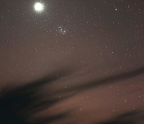Seeing stars

FOR ALL THE TIME THAT HUMANITY has spent gazing at the stars, we still know shockingly little about what they actually look like. Even with the biggest telescopes, nearly every star except our Sun appears as a speck of light, their surfaces hidden from view.
Some stars, however, are ready for their close-up.
At the southern tip of the constellation Andromeda sits Zeta Andromedae, a moderately bright orange giant that is now part of an elite club: It is one of a handful of stars to have its surface mapped by astronomers. In 2016, Rachael Roettenbacher (Yale University) and colleagues revealed the star’s portrait in new detail: a patchy orb 15 times as wide as the Sun and slathered in gargantuan dark spots.
Zeta’s portrait isn’t like the gorgeous space images that grace magazine covers. This picture is blurry and pixelated. But to astronomers it is captivating, and a reminder that much about stars remains a mystery.
“Everything we do in astronomy is based on our understanding of stars.”
In the case of Zeta, the puzzle is its pockmarked face. Star spots mark where magnetic fields punch through the surface, and Zeta’s spots are laid out differently than spots on the Sun. While sunspots gather in mid-latitude bands, symmetrically straddling the equator, Zeta’s show up everywhere with no discernible pattern. The Sun is free of spots at its highest latitudes; Zeta has one large spot squatting on its north pole.
“Every star is uniquely complicated,” Roettenbacher says. “We don’t have too many of these surfaces, but we do see that they’re all distinctly
You’re reading a preview, subscribe to read more.
Start your free 30 days



